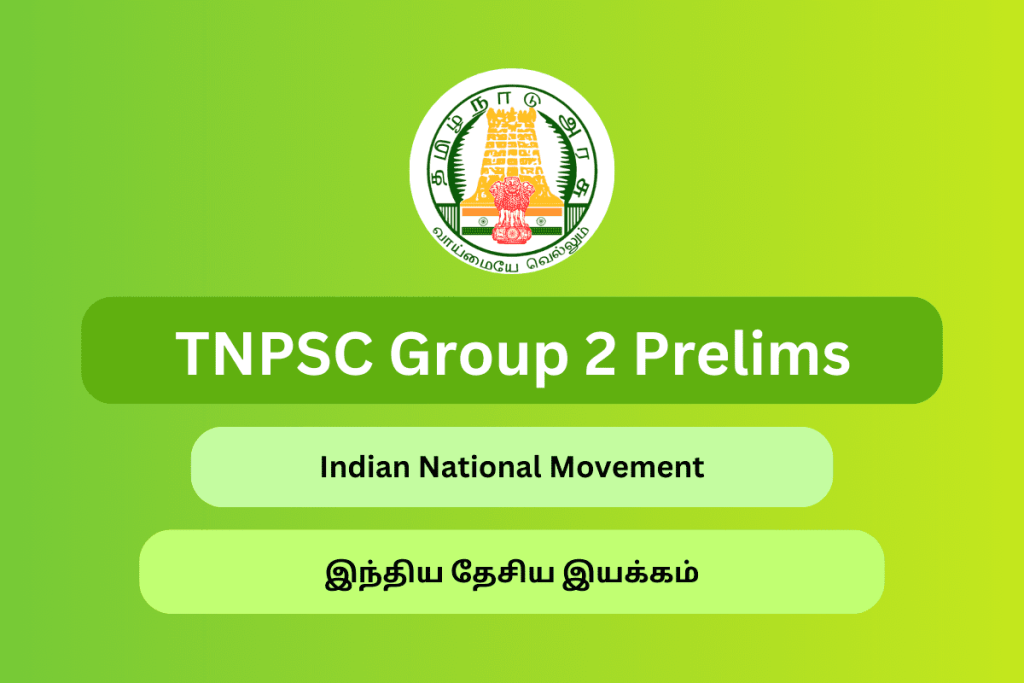Unraveling the India’s Freedom Struggle: A Guide to TNPSC Group 2-2A Prelims Indian National Movement
The Indian National Movement holds a paramount significance in the TNPSC Group 2 Prelims examination, serving as a testament to the indomitable spirit of the Indian people in their quest for freedom and self-determination. In this article, we delve into the significance of the Indian National Movement section in the examination and outline effective preparation strategies to navigate through it successfully.

Understanding the TNPSC Group 2 Prelims Syllabus on Indian National Movement
The Indian National Movement segment in TNPSC Group 2 Prelims covers a wide range of topics, including the early phase of the freedom struggle, the emergence of Indian nationalism, the role of leaders and organizations, socio-religious movements, and the struggle for independence. Candidates are expected to have a comprehensive understanding of these topics to excel in the examination.
| Indian National Movement இந்திய தேசிய இயக்கம் |
Study Materials for Indian National Movement
Tracing the Early Phases of the Freedom Struggle: The Indian National Movement traces its origins to the early 19th century, marked by the advent of socio-religious reform movements and the emergence of Indian nationalist sentiments. Candidates should familiarize themselves with key events such as the Revolt of 1857, the formation of Indian National Congress, and the contributions of early nationalist leaders.
Exploring the Emergence of Indian Nationalism: The late 19th and early 20th centuries witnessed the rise of Indian nationalism, fueled by factors such as economic exploitation, racial discrimination, and political marginalization. Candidates should understand the ideological underpinnings of Indian nationalism and the contributions of leaders such as Bal Gangadhar Tilak, Dadabhai Naoroji, and Gopal Krishna Gokhale.
- TNPSC Group 2 Prelims Study Materials for Geography of India
- TNPSC Group 2 Prelims Study Materials for Current Affairs
- TNPSC Group 2 Prelims Study Materials for General Science
Analyzing the Role of Leaders and Organizations: The Indian National Movement saw the emergence of several leaders and organizations that played a pivotal role in mobilizing the masses and spearheading the struggle for independence. Candidates should have knowledge of leaders such as Mahatma Gandhi, Jawaharlal Nehru, Subhas Chandra Bose, and organizations such as the Indian National Congress, All India Muslim League, and revolutionary groups.
Understanding Socio-religious Movements: Socio-religious movements such as the Arya Samaj, Brahmo Samaj, Aligarh Movement, and the Khilafat Movement played a significant role in the Indian National Movement. Candidates should comprehend the objectives, leaders, and impact of these movements on the freedom struggle.
Analyzing the Struggle for Independence: The struggle for independence culminated in India’s independence in 1947, following decades of non-violent protests, civil disobedience movements, and mass mobilization. Candidates should understand the significance of events such as the Quit India Movement, the Partition of India, and the role of leaders in negotiating with the British for independence.
TNPSC Group 2 Prelims Preparation Strategies 2024
To excel in the Indian National Movement section of TNPSC Group 2 Prelims, aspirants can adopt the following preparation strategies:
- Study from Standard Textbooks: Refer to standard textbooks on Indian History recommended for competitive examinations to build a strong conceptual foundation.
- Analyze Historical Documents and Speeches: Read historical documents, speeches, and writings of leaders involved in the Indian National Movement to understand their perspectives and motivations.
- Solve Previous Year Papers: Solve previous year question papers and attempt mock tests to familiarize yourself with the exam pattern, question types, and time management strategies.
- Focus on Conceptual Understanding: Instead of rote memorization, focus on understanding the causes, consequences, and significance of key events and movements in the Indian National Movement.
- Analyze Current Affairs: Relate the Indian National Movement to current affairs and analyze its relevance in contemporary times. Follow reputable historical newspapers, magazines, and online portals for relevant news and analysis.
- Revision is Key: Allocate dedicated time for regular revision of topics related to the Indian National Movement to reinforce learning and improve retention.
Conclusion on Indian National Movement
In conclusion, mastering the Indian National Movement section is essential for success in TNPSC Group 2 Prelims. By delving into the intricacies of the freedom struggle, understanding the contributions of leaders and organizations, and analyzing its socio-political implications, aspirants can enhance their knowledge and analytical skills, thereby increasing their chances of scoring well in this section of the examination. Remember, a deep understanding of the Indian National Movement not only aids in examination preparation but also fosters a sense of pride and appreciation for India’s rich history of struggle and sacrifice.









